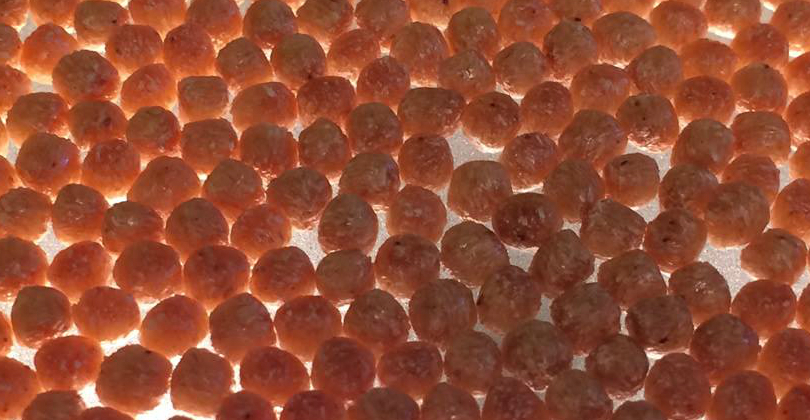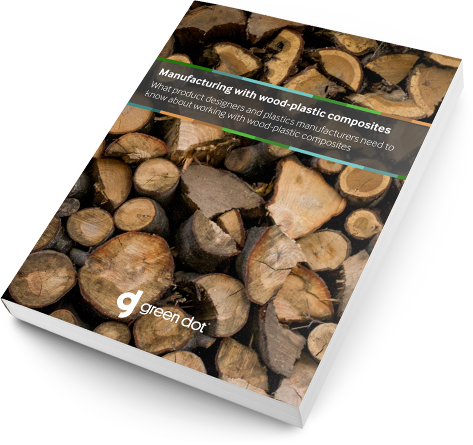Processing considerations for wood-plastic composites
We’ve discussed factors of wood-plastic composite that affect design, but what about during the processing phase of plastic production? Wood-plastic composites continue to stick to the theme of being relatively similar to traditional plastics in terms of processing, but again, there are a few things manufacturers should consider when using these remarkable materials.
Pellet size
Pellet size is an important aspect in plastic production no matter which feedstock is used. This is no less true when working with wood-plastic composite pellets. Despite this reality, some wood-plastic composite suppliers seem to ignore the importance of small, rounded pellets during the production phase. They’re simply unwilling to invest in the machinery necessary to achieve uniformity or to go through the time-consuming drying procedures required by more precise pellet cutting methods.

When pellets are too large they have a tendency to melt unevenly, create additional friction and settle into a structurally inferior final product. The ideal pellet should be about the size of a small BB and rounded to achieve an ideal surface to volume ratio. These dimensions facilitate drying and help to ensure a smooth flow throughout the production process. Manufacturers working with wood-plastic composites should expect the same shape and uniformity they associate with traditional plastics. The presence of organic filler is no excuse for chaotically sized pellets.
Moisture and temperature
Low moisture content, again an important consideration in any plastic production, is essential to creating high quality plastics with organic fillers. A properly designed manufacturing process can bear most of the burden of reducing the presence of moisture. In an operation designed to first-and-foremost produce wood-plastic composite materials, much of the machinery in the facility should be dedicated to drying. Organic fillers need to be dried properly before being added to the plastic, or the two will not bond correctly. The composites need to be dried again before being packaged to avoid the onset of molding and eventual degradation of the product. Ideally, customers themselves will not have to dry composite plastics once they’ve arrived at their facility. Low moisture content is something manufacturers should simply demand from their suppliers.
Processing temperatures are one of the few portions of the manufacturing phase where wood-plastic composites differ significantly from conventional plastics. Wood-plastic composites generally process in temperatures around 50 degrees lower than the same, unfilled material. Most wood additives will begin to burn at around 400 degrees Fahrenheit.
Melting wood-plastic composites at too high of a temperature risks shearing— pushing a material that’s too hot, through too small of a gate, where the increased friction burns the wood and causes discoloration and a degraded plastic. This problem can be avoided by running wood-plastic composites at a lower temperature, ensuring the gate size is adequate and removing any unnecessary turns or right angles along the processing pathway.
Relatively low processing temperatures means that manufacturers seldom need to achieve higher temperatures than a traditional polypropylene. This eliminates the difficult task of taking heat out of the manufacturing process. There’s no need for the addition of mechanical cooling equipment, molds specifically designed to reduce heat or other extraordinary measures. This means further reduced cycle times for manufacturers, on top of already faster cycle times due to the presence of organic fillers.
Wood-plastic composites are also compatible with foaming agents. The addition of these foaming agents can create a balsa-like material. This is a useful property when the finished product needs to be especially lightweight or buoyant.
What it all means for manufacturers
When it comes to processing techniques, wood-plastic composites behave similar to any other plastic. During foaming, extrusion and injection molding, wood-plastic composites are compatible with existing machinery. For injection molding, the above considerations should be taken into account regarding gate size and positioning, but the overall process remains the same. With standard extruding equipment, uniformly sized wood-plastic composite pellets will have no problem performing up to expectations.
All of the above properties, combined with science-based green product design, make working with wood-plastic composites an experience that will feel familiar to many plastics manufacturers, with the added satisfaction of a reduced impact on the planet. For more on what to consider when working with wood-plastic composites, download our white paper using the form below.

Working with wood-plastic composites
Why plastics manufacturers have nothing to fear by switching to a wood-plastic composite alternative material


